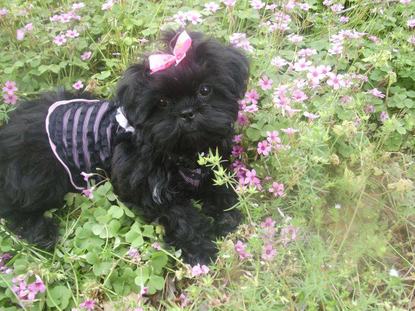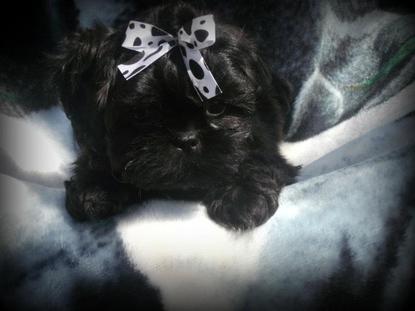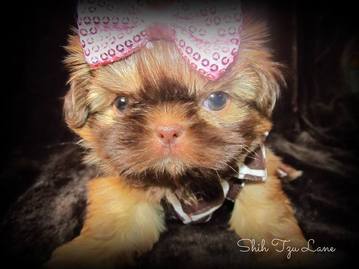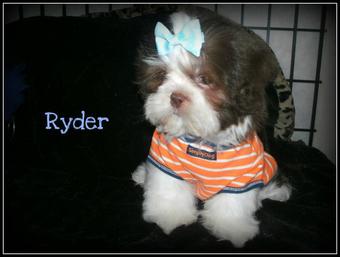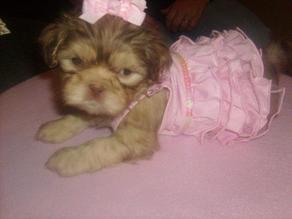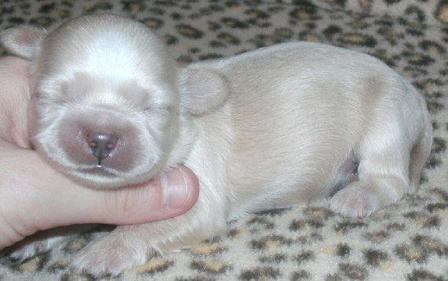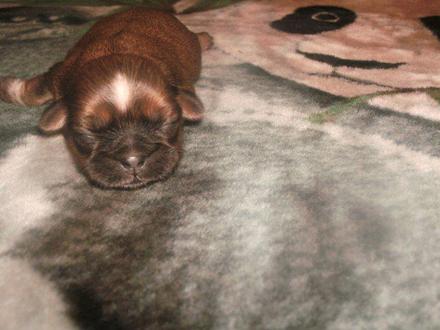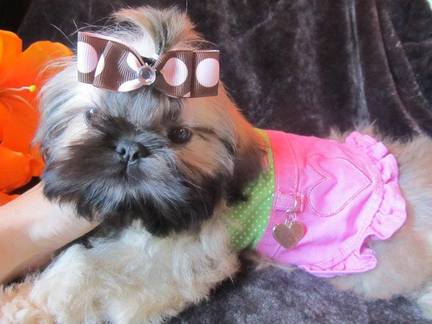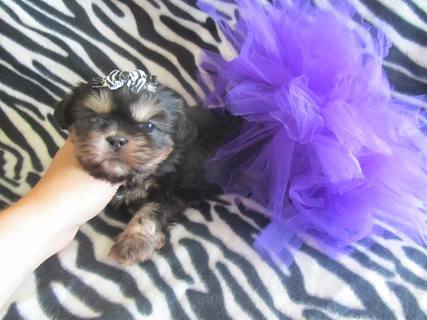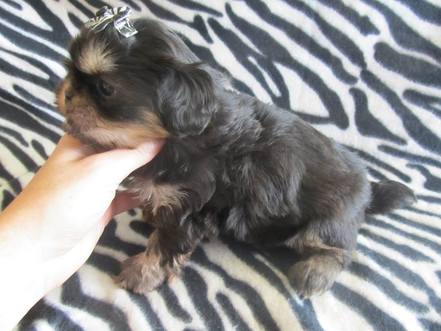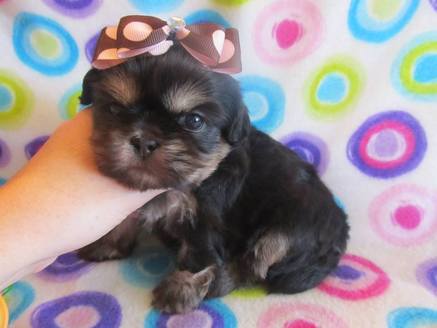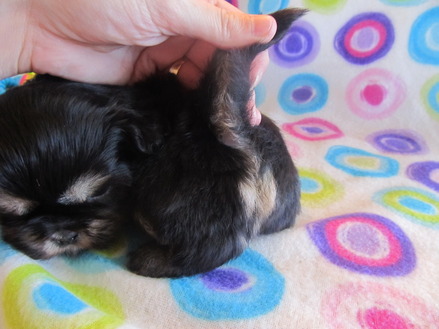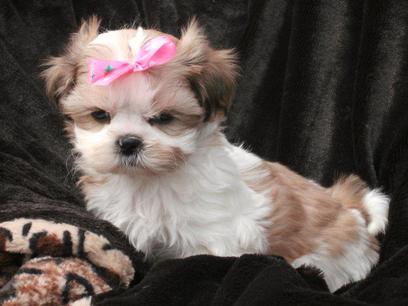Examples of Colors in the Shih Tzu, And how the coat color can change
* Written By: Shih Tzu Lane, DO NOT COPY and put on YOUR website! *
* Written By: Shih Tzu Lane, DO NOT COPY and put on YOUR website! *
There are 3 different types of NOSES in a Shih Tzu to determine color.
1. Black nose(the most common Shih Tzu, you see these everywhere.) - A Black and white and Gold and White are the most common colors. A Black nose is the default nose color. If the Shih Tzu has a black nose, (black eye rims, lips, paw pads which are called points) then you only go by the color of the coat to determine what color the dogs is. Most Newborn Black Nosed Shih Tzu puppies are born with a BLACK nose at birth. Some are born with a pink nose that will begin to turn black within the first 3 days. A solid black is more exotic than a classic Black and White.
** The Exotic and Rares ** ( the next 2, the COLOR of the dog is determined by what color the NOSE is)
2. Liver- ( an Exotic Color ) Liver is a dilute color, Liver dogs have noses ranging from deep brown to pink. It is genetically impossible for a liver dog to have a black or blue nose. If the Shih Tzu has a liver (brown/chocolate/pink) nose, eye rims, lips, pads. It is a Liver Shih Tzu, it doesn't matter what color the coat is on these dogs its still a liver. Anything except black, It is impossible to have a strand of black anywhere to be a liver because liver lacks the black color gene. Newborn Liver Shih Tzu puppies are born with a PINK nose and later gets darker to the liver color. A liver nose will not have ANY blue or Black spots on the nose. If you see any dark spots on a pink nose. It is NOT a Liver.
There is also a nose color called Isabella, which is VERY rare. The Isabella color is a dilute color of the Liver.
3. Blue- ( A Rare Color, most people have never seen these, not every breeder can produce these) Blue is also a dilute color which is the dilute color of black. Blue dogs have noses ranging from light grey to almost black. It is genetically impossible for a blue dog to have a liver or black nose. Sometimes blues can also be very dark, so that their coat and nose appear almost black. It can be very difficult to tell whether such dogs are blacks or blues.
DO NOT confuse a SILVER Shih Tzu with a BLUE Shih Tzu. A Silver has a BLACK nose, A Blue has a BLUE nose.
Sometimes blue can be tricky and hard to determine, Some noses are obvious and are light purplish blue or light gray, but some are a real dark gunmetal, and you may think it's black. Most blue Shih Tzu's have blue (looks grey) eye rims, lips and paw pads, Blue Shih Tzu can have any color coat except Black like the liver because of the dilute color gene. Some Blue Shih Tzu's are born very dark and may look black to the eye. But they are not black and may Change to a lighter blue in adulthood. Just because the coat on a dog looks blue does NOT make it a blue Shih Tzu. Go by the Nose. You can tell the colors better in bright light outdoors. Compare a blue nose with a black nose to see the difference. Newborn blue Shih Tzu puppies are born with a PINK nose, and will change to blue within 1-3 weeks. A "True Blue" Shih Tzu will have a blue nose AND blue coat.
Both the Color Liver and Blue are dilute genes. You MUST have a Blue or Liver Shih Tzu or a carrier (parents, grandparents) to produce these colors.
*** If you have a Shih Tzu with a BLACK nose, you have a ( whatever the color your dog's coat is)
If you have a Shih Tzu with a LIVER nose, you have a Liver Shih Tzu
If you have a Shih Tzu with a BLUE nose, you have a Blue Shih Tzu
Some Shih Tzus will get lighter as they reach adulthood and the puppy coat grows out, While other Shih Tzus will get darker. That is all based on genetics and the color of the parents etc.
For example- If I breed 2 cream Shih Tzu's together, the puppies may appear another color other than cream at birth, but the undercoat (closest to the skin) will be cream. As the puppy ages, the undercoat will begin to grow out leaving only the cream color. Most of the time, you can tell what color a young puppy will turn by looking at the color around the eyes and under the tail. It will take a few weeks to notice the color changing around the eyes. Usually the color under the tail is there at birth in most. In Parti colors, the White will not be affected and will remain white. Sometimes I have puppies that are born cream, other times I have puppies that are born light brown/gold etc, and fade out to cream as adults. If the undercoat is not lighter than the topcoat, the color won't fade as much, if any. It is hard to tell anything at all about newborns. You will need to wait a few weeks until the hair begins to get longer before you are able to see the undercoat well.
Black is a dominate color. Liver and Blue are dilute. In Liver and Blue's your dogs must carry the liver or blue gene in order to produce that color offspring.
If you breed a black dog to a white dog, black is dominate and you will produce more (or all) black puppies than you would white. A Black Parent will allow the puppies to Hold their color and not fade as much. A lighter color like white or cream (if not bred to a black dog), will more than likely fade to a lighter color as an adult. A Black puppy at birth may turn Silver at adulthood (that does not make it a Blue). If you want a Dark Chocolate that does not fade, try breeding a chocolate liver to a black, or Gold to Black, Same goes for red and any other color you are trying to produce. Two Blue Shih Tzu's bred together can produce black. However, it is NOT advised to breed 2 strong lined Blue's together, unless you know what you are doing.
All Shih Tzu's are born with a bluish cast to their eyes. This does not mean they will have blue eyes. Their eye color will begin to change later. Liver puppy eyes can start at blue and change to green with most ending in Amber/Gold colored eyes. Blue Shih Tzu can have normal to light colored eyes and some have Blue eyes. Blue eyes are accepted by AKC ONLY in Blue Dogs. But your dogs will need to carry that gene to produce blue eyes. Not ALL blue Shih Tzu will have blue eyes.
I see other websites all the time that says, There is no "Rare" color for a Shih Tzu, they are all equally the same. This is not true and most of the breeders that will tell you that can't even produce those colors that they are trying to describe. A Blue Shih Tzu IS Rare. You cannot produce a Blue Shih Tzu with any color other than a Blue Shih Tzu. If you Could, Then it would not be considered a "Rare Color". There are other rare colors, that are even more dilute, they are Isabella and Lavander.
Dobie Markings: These types of markings are also Rare. Dobie describes the markings on the puppy. The markings are similar to the markings on a Doberman Pinscher, and that is where the term "Dobie" originated. Your parents will have to carry this gene to produce a Dobie. The markings are tan above the eyes, on the cheeks, across the chest, down the legs and under the tail.
This page is still under construction.
>>>>>>>>>>> CLICK HERE TO SEE OUR PUPPIES<<<<<<<<<<<<<<<
1. Black nose(the most common Shih Tzu, you see these everywhere.) - A Black and white and Gold and White are the most common colors. A Black nose is the default nose color. If the Shih Tzu has a black nose, (black eye rims, lips, paw pads which are called points) then you only go by the color of the coat to determine what color the dogs is. Most Newborn Black Nosed Shih Tzu puppies are born with a BLACK nose at birth. Some are born with a pink nose that will begin to turn black within the first 3 days. A solid black is more exotic than a classic Black and White.
** The Exotic and Rares ** ( the next 2, the COLOR of the dog is determined by what color the NOSE is)
2. Liver- ( an Exotic Color ) Liver is a dilute color, Liver dogs have noses ranging from deep brown to pink. It is genetically impossible for a liver dog to have a black or blue nose. If the Shih Tzu has a liver (brown/chocolate/pink) nose, eye rims, lips, pads. It is a Liver Shih Tzu, it doesn't matter what color the coat is on these dogs its still a liver. Anything except black, It is impossible to have a strand of black anywhere to be a liver because liver lacks the black color gene. Newborn Liver Shih Tzu puppies are born with a PINK nose and later gets darker to the liver color. A liver nose will not have ANY blue or Black spots on the nose. If you see any dark spots on a pink nose. It is NOT a Liver.
There is also a nose color called Isabella, which is VERY rare. The Isabella color is a dilute color of the Liver.
3. Blue- ( A Rare Color, most people have never seen these, not every breeder can produce these) Blue is also a dilute color which is the dilute color of black. Blue dogs have noses ranging from light grey to almost black. It is genetically impossible for a blue dog to have a liver or black nose. Sometimes blues can also be very dark, so that their coat and nose appear almost black. It can be very difficult to tell whether such dogs are blacks or blues.
DO NOT confuse a SILVER Shih Tzu with a BLUE Shih Tzu. A Silver has a BLACK nose, A Blue has a BLUE nose.
Sometimes blue can be tricky and hard to determine, Some noses are obvious and are light purplish blue or light gray, but some are a real dark gunmetal, and you may think it's black. Most blue Shih Tzu's have blue (looks grey) eye rims, lips and paw pads, Blue Shih Tzu can have any color coat except Black like the liver because of the dilute color gene. Some Blue Shih Tzu's are born very dark and may look black to the eye. But they are not black and may Change to a lighter blue in adulthood. Just because the coat on a dog looks blue does NOT make it a blue Shih Tzu. Go by the Nose. You can tell the colors better in bright light outdoors. Compare a blue nose with a black nose to see the difference. Newborn blue Shih Tzu puppies are born with a PINK nose, and will change to blue within 1-3 weeks. A "True Blue" Shih Tzu will have a blue nose AND blue coat.
Both the Color Liver and Blue are dilute genes. You MUST have a Blue or Liver Shih Tzu or a carrier (parents, grandparents) to produce these colors.
*** If you have a Shih Tzu with a BLACK nose, you have a ( whatever the color your dog's coat is)
If you have a Shih Tzu with a LIVER nose, you have a Liver Shih Tzu
If you have a Shih Tzu with a BLUE nose, you have a Blue Shih Tzu
Some Shih Tzus will get lighter as they reach adulthood and the puppy coat grows out, While other Shih Tzus will get darker. That is all based on genetics and the color of the parents etc.
For example- If I breed 2 cream Shih Tzu's together, the puppies may appear another color other than cream at birth, but the undercoat (closest to the skin) will be cream. As the puppy ages, the undercoat will begin to grow out leaving only the cream color. Most of the time, you can tell what color a young puppy will turn by looking at the color around the eyes and under the tail. It will take a few weeks to notice the color changing around the eyes. Usually the color under the tail is there at birth in most. In Parti colors, the White will not be affected and will remain white. Sometimes I have puppies that are born cream, other times I have puppies that are born light brown/gold etc, and fade out to cream as adults. If the undercoat is not lighter than the topcoat, the color won't fade as much, if any. It is hard to tell anything at all about newborns. You will need to wait a few weeks until the hair begins to get longer before you are able to see the undercoat well.
Black is a dominate color. Liver and Blue are dilute. In Liver and Blue's your dogs must carry the liver or blue gene in order to produce that color offspring.
If you breed a black dog to a white dog, black is dominate and you will produce more (or all) black puppies than you would white. A Black Parent will allow the puppies to Hold their color and not fade as much. A lighter color like white or cream (if not bred to a black dog), will more than likely fade to a lighter color as an adult. A Black puppy at birth may turn Silver at adulthood (that does not make it a Blue). If you want a Dark Chocolate that does not fade, try breeding a chocolate liver to a black, or Gold to Black, Same goes for red and any other color you are trying to produce. Two Blue Shih Tzu's bred together can produce black. However, it is NOT advised to breed 2 strong lined Blue's together, unless you know what you are doing.
All Shih Tzu's are born with a bluish cast to their eyes. This does not mean they will have blue eyes. Their eye color will begin to change later. Liver puppy eyes can start at blue and change to green with most ending in Amber/Gold colored eyes. Blue Shih Tzu can have normal to light colored eyes and some have Blue eyes. Blue eyes are accepted by AKC ONLY in Blue Dogs. But your dogs will need to carry that gene to produce blue eyes. Not ALL blue Shih Tzu will have blue eyes.
I see other websites all the time that says, There is no "Rare" color for a Shih Tzu, they are all equally the same. This is not true and most of the breeders that will tell you that can't even produce those colors that they are trying to describe. A Blue Shih Tzu IS Rare. You cannot produce a Blue Shih Tzu with any color other than a Blue Shih Tzu. If you Could, Then it would not be considered a "Rare Color". There are other rare colors, that are even more dilute, they are Isabella and Lavander.
Dobie Markings: These types of markings are also Rare. Dobie describes the markings on the puppy. The markings are similar to the markings on a Doberman Pinscher, and that is where the term "Dobie" originated. Your parents will have to carry this gene to produce a Dobie. The markings are tan above the eyes, on the cheeks, across the chest, down the legs and under the tail.
This page is still under construction.
>>>>>>>>>>> CLICK HERE TO SEE OUR PUPPIES<<<<<<<<<<<<<<<
